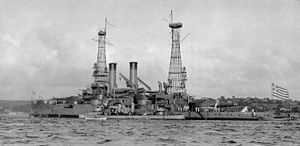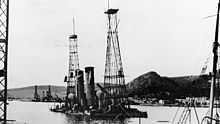Greek battleship Lemnos
 Lemnos – Θ/Κ Λήμνος | |
| Career (Greece) | |
|---|---|
| Name: | Lemnos |
| Namesake: | Naval Battle of Lemnos |
| Laid down: | May 12, 1904 |
| Launched: | December 9, 1905 |
| Commissioned: | July 22, 1914 |
| Decommissioned: | 1932 |
| Fate: | Sunk on April 23, 1941 near Salamis |
| Notes: | previously USS Idaho (BB-24) |
| General characteristics | |
| Class and type: | Mississippi-class battleship |
| Displacement: | Design: 13,000 long tons (13,000 t) Full load: 14,465 long tons (14,697 t) |
| Length: | 382 ft (116.4 m) |
| Beam: | 77 ft (23.5 m) |
| Draft: | 24 ft 8 in (7.5 m) |
| Installed power: | 10,000 ihp (7,500 kW) |
| Propulsion: | 2 × Triple-expansion reciprocating engines 8 × Babcock & Wilcox boilers |
| Speed: | 17-knot (20 mph; 31 km/h) maximum |
| Crew: | 744 |
| Armament: | 4 × 12-inch (305 mm) guns 8 × 8-inch (203 mm) guns 8 × 7-inch (178 mm) guns 12 × 3-inch (76 mm) guns 6 × 3-pounder guns 2 × 1-pounder guns 2 × 21-inch (533 mm) torpedo tubes |
| Armor: | Belt: 9 in (229 mm) Turrets: 12 in (305 mm) Conning tower: 9 in (229 mm) |
Lemnos, sometimes spelled Limnos (Greek: Θ/Κ Λήμνος), was a 13,000 ton Mississippi-class battleship originally built by the United States Navy in 1904–1908. As Idaho, she was purchased by the Greek Navy in 1914 and renamed Lemnos, along with her sister Mississippi, renamed Kilkis. Lemnos was named for the Battle of Lemnos, a crucial engagement of the First Balkan War. Armed with a main battery of four 12 in (305 mm) guns, Lemnos and her sister were the most powerful vessels in the Greek fleet.
The ship saw limited action during World War I. Greece's pro-German monarch, Constantine I opted to remain neutral until October 1916, when pressure from the Triple Entente forced him to abdicate in favor of a pro-Entente government. For the remainder of the war, Lemnos operated solely as a harbor defense ship. In the aftermath of World War I, she saw service during the Allied intervention in the Russian Civil War and the Greco-Turkish War of 1919–1922. During the war with Turkey, Lemnos supported Greek landings in Turkey and participated in the final Greek sea-borne withdrawal in 1922. She remained in service until 1932, when she was used as a barracks ship and subsequently disarmed. During the German invasion of Greece in 1941, she and her sister were sunk in Salamis by German Junkers Ju 87 dive bombers. The two ships were ultimately raised and broken up for scrap after the end of the war.
Construction
Laid down on 12 May 1904, the ship was launched on 9 December 1905 and commissioned into the United States Navy on 1 April 1908 as USS Idaho.[1] She served in the US Navy until 1914, when she and her sister were sold on 30 June 1914.[2] The two ships were transferred to the Greek Navy in Newport News, Virginia the following month.[3] The ship was 382 feet (116 m) long overall and had a beam of 77 ft (23 m) and a draft of 24 ft 8 in (7.52 m). She displaced 13,000 metric tons (13,000 long tons; 14,000 short tons) as designed and up to 14,465 t (14,237 long tons; 15,945 short tons) at full combat load. The ship was powered by two-shaft vertical triple expansion engines and eight coal-fired Babcock & Wilcox boilers rated at 10,000 indicated horsepower (7,500 kW) and a top speed of 17 knots (20 mph; 31 km/h). Lattice masts were installed in 1909. She had a crew of 744 officers and enlisted men.[1]
The ship was armed with a main battery of four 12 in (305 mm) L/45 guns in two twin turrets, one on either end of the superstructure. Eight 8 in (203 mm) L/45 guns were mounted in four twin turrets, two on other side of the vessel amidships. The secondary battery was rounded out with eight 7 in (178 mm) L/45 guns mounted individually in casemates along the length of the hull. Close-range defense against torpedo boats was protected by a battery of twelve 3 in (76 mm) L/50 guns, six 3-pounder guns and two 1-pounder guns. The ship's armament system was completed by two 21 in (533 mm) torpedo tubes submerged in her hull.[1] Lemnos and Kilkis were the most powerful vessels in the Greek Navy.[4]
Service history
Lemnos and Kilkis quickly left the United States after their transfer in July 1914, due to the rising tensions in Europe following the assassination of Archduke Franz Ferdinand of Austria the previous month.[5] At the outbreak of World War I in at the end of the month, Greece's pro-German monarch, Constantine I, decided to remain neutral. The Entente powers landed troops in Salonika in 1915, which was a source of tension between France and Greece. Ultimately, the French seized the Greek Navy on 19 October 1916 (see Noemvriana and National Schism).[6] Lemnos was reduced to a skeleton crew and had the breech blocks for her guns removed to render them inoperable. All ammunition and torpedoes were also removed.[7] Ultimately, a pro-Entente government replaced Constantine and declared war on the Central Powers. Lemnos, however, did not see active service with Greece's new allies,[6] and instead was used solely for harbor defense until the end of the war.[4]

After the end of World War I, Lemnos joined the Allied intervention in the Russian Civil War and served with the Crimean Expedition. There, she aided the White Russians against the Communists.[8] She then saw service during the Greco-Turkish War, where she supported landings to seize Ottoman territory. The Ottoman Navy had been interned by the Allies after the end of World War I, and so provided no opposition to the Greek Navy's activities. Operations came to a close in September 1922 when the Greek Army was forced to evacuate by sea, along with a sizable number of civilians, from Asia Minor. The fleet transported a total of 250,000 soldiers and civilians during the evacuation.[6] In 1932, Lemnos was placed in inactive reserve; sections of her armor plate was removed to build fortifications on the island of Aegina.[2] She was disarmed in 1937 and thereafter used as a barracks ship.[9] The hulk of Lemnos was bombed in Salamis Naval Base by Junkers Ju 87 dive bombers on April 23, 1941, during the German invasion of Greece.[2] The ship was beached to prevent her from sinking; her wreck was broken up after the end of the war.[8]
Footnotes
- ↑ 1.0 1.1 1.2 Gardiner, p. 144
- ↑ 2.0 2.1 2.2 Gardiner & Gray, p. 384
- ↑ Hore, p. 89
- ↑ 4.0 4.1 Paloczi-Horvath, p. 80
- ↑ Parramore et al., p. 292
- ↑ 6.0 6.1 6.2 Gardiner & Gray, p. 383
- ↑ Fotakis, p. 131
- ↑ 8.0 8.1 "Idaho". Naval History & Heritage Command. 28 September 2007. Retrieved 6 December 2011.
- ↑ Gardiner & Chesneau, p. 404
References
- Fotakis, Zisis (2005). Greek Naval Strategy and Policy, 1910–1919. New York, NY: Routledge. ISBN 978-0-415-35014-3.
- Gardiner, Robert, ed. (1979). Conway's All the World's Fighting Ships 1860–1905. Greenwich, UK: Conway Maritime Press. ISBN 0-8317-0302-4.
- Gardiner, Robert; Gray, Randal, eds. (1984). Conway's All the World's Fighting Ships: 1906–1922. Annapolis, MD: Naval Institute Press. ISBN 0-87021-907-3.
- Gardiner, Robert; Chesneau, Roger (1980). Conway's All the World's Fighting Ships, 1922–1946. Annapolis, MD: Naval Institute Press. ISBN 0-87021-913-8.
- Hore, Peter (2006). Battleships of World War I. London, UK: Southwater Books. ISBN 978-1-84476-377-1.
- Paloczi-Horvath, George (1996). From Monitor to Missile Boat : Coast Defence Ships and Coastal Defence since 1860. London, UK: Conway Maritime Press. ISBN 0-85177-650-7.
- Parramore, Thomas C.; Stewart, Peter C; Bogger, Tommy (2000). Norfolk: The First Four Centuries. Charlottesville, VA: University Press of Virginia. ISBN 0-8139-1988-6.
| ||||||||||||||||||